
Trois mouvements de Petrouchka or Three Movements from Petrushka is an arrangement for piano of music from the ballet Petrushka by the composer Igor Stravinsky for the pianist Arthur Rubinstein.

Trois mouvements de Petrouchka or Three Movements from Petrushka is an arrangement for piano of music from the ballet Petrushka by the composer Igor Stravinsky for the pianist Arthur Rubinstein.
Sergei Diaghilev, who had commissioned The Firebird from Stravinsky for his new ballet company, the Ballets Russes, had expected Stravinsky would follow the ballet with another dance work, The Rite of Spring . The idea for such a work had occurred to Stravinsky while still working on The Firebird, but Stravinsky felt the need to write something unrelated to the theater and conceived an orchestral work in which the piano would have a prominent part: Stravinsky himself used the word Konzertstück for the composition. [1]
Stravinsky relates that he had in mind a distinct picture of a puppet who tried the patience of the orchestra with "diabolical cascades of arpeggios." In turn, the orchestra retaliates with trumpet blasts and after reaching a climax, the conflict ends with the collapse of the puppet. Stravinsky recalled that after completing the piece, he searched vainly for an appropriate name for his puppet until he remembered Petrushka, a popular hero of country fairs everywhere. [1]
In the fall of 1910, Diaghilev came to visit Stravinsky, who at that time was living in Lausanne, Switzerland, expecting to hear the beginning of The Rite of Spring, but instead was greeted with Petrushka. Diaghilev immediately recognized the possibilities of developing this orchestral work into a full length stage work. Thus, the concert piece became the second part of the ballet Petrushka . The full score was completed on 11 May 1911, and on the following 13 June Petrushka was performed by Diaghilev's Ballets Russes at the Theatre du Chatelet in Paris, under the baton of Pierre Monteux. [1]
Three Movements from Petrushka for the solo piano were composed ten years later for his friend, pianist Arthur Rubinstein, and are dedicated to him. Stravinsky is very explicit in stating that the movements are not transcriptions. He was not trying to reproduce the sound of the orchestra, but instead wished to compose a score which would be essentially pianistic even though its musical material was drawn directly from the ballet. Stravinsky also wanted to create a work which would encourage pianists to play his music, but it should be one in which they could display their technique, an objective he amply achieved. [1]
The three movements are as follows:
The first movement, "Danse Russe", is drawn from the closing part of the first scene of the ballet. The next part, "Chez Pétrouchka", is the second scene of the stage work, while the final movement, "La semaine grasse", includes the whole of the fourth scene up to the end of the Masqueraders section to which Stravinsky added an ending which he later incorporated in his 1947 revised version of the ballet for concert performances.
He completed the three movements in August 1921 at Anglet, France. [1]
Stravinsky's goal in arranging Petrushka for the piano (along with Piano-Rag-Music ) was to attempt to influence Arthur Rubinstein into playing his music. (A 1961 live recording featuring Rubinstein at Carnegie Hall was published in 2012.) [2] In order to gain the latter's attention, Stravinsky ensured that Rubinstein would find the arrangement technically challenging but musically satisfying. Trois mouvements de Petrouchka reflects the composer's intentions and, unsurprisingly, it is renowned for its notorious technical and musical difficulties. All three movements include wild and rapid jumps which span over two octaves, complex polyrhythms, extremely fast scales, and tremolos. The third and largest movement is known for long, relentless trills in thirds, some even in the four fingers of the left hand while the thumb carries a separate melody.

Igor Fyodorovich Stravinsky was a Russian composer and conductor with French citizenship and United States citizenship. He is widely considered one of the most important and influential composers of the 20th century and a pivotal figure in modernist music.

The Rite of Spring is a ballet and orchestral concert work by the Russian composer Igor Stravinsky. It was written for the 1913 Paris season of Sergei Diaghilev's Ballets Russes company; the original choreography was by Vaslav Nijinsky with stage designs and costumes by Nicholas Roerich. When first performed at the Théâtre des Champs-Élysées on 29 May 1913, the avant-garde nature of the music and choreography caused a sensation. Many have called the first-night reaction a "riot" or "near-riot", though this wording did not come about until reviews of later performances in 1924, over a decade later. Although designed as a work for the stage, with specific passages accompanying characters and action, the music achieved equal if not greater recognition as a concert piece and is widely considered to be one of the most influential musical works of the 20th century.
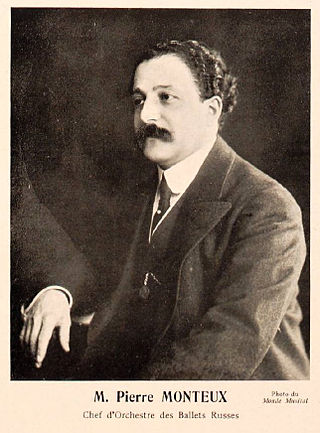
Pierre Benjamin Monteux was a French conductor. After violin and viola studies, and a decade as an orchestral player and occasional conductor, he began to receive regular conducting engagements in 1907. He came to prominence when, for Sergei Diaghilev's Ballets Russes company between 1911 and 1914, he conducted the world premieres of Stravinsky's The Rite of Spring and other prominent works including Petrushka, The Nightingale, Ravel's Daphnis et Chloé, and Debussy's Jeux. Thereafter he directed orchestras around the world for more than half a century.
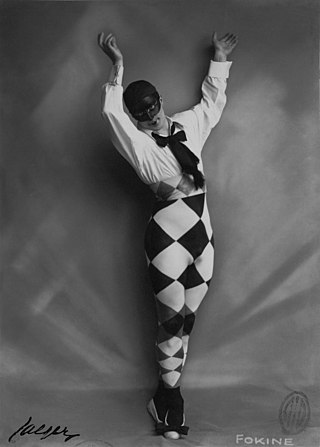
Michael Fokine was a Russian choreographer and dancer.

Bronislava Nijinska was a Russian ballet dancer of Polish origin, and an innovative choreographer. She came of age in a family of traveling, professional dancers.

Alexander Tansman was a Polish composer, pianist and conductor who became a naturalized French citizen in 1938. One of the earliest representatives of neoclassicism, associated with École de Paris, Tansman was a globally recognized and celebrated composer.

Pulcinella is a 21-section ballet by Igor Stravinsky with arias for soprano, tenor and bass vocal soloists, and two sung trios. It is based on the 18th-century play Quatre Polichinelles semblables, or Four similar Pulcinellas, revolving around a stock character from commedia dell'arte. The work premiered at the Paris Opera on 15 May 1920 under the baton of Ernest Ansermet. The central dancer, Léonide Massine, created both the libretto and the choreography, while Pablo Picasso designed the costumes and sets. The ballet was commissioned by Sergei Diaghilev, impresario of the Ballets Russes. A complete performance takes 35–40 minutes. Stravinsky revised the score in 1965.
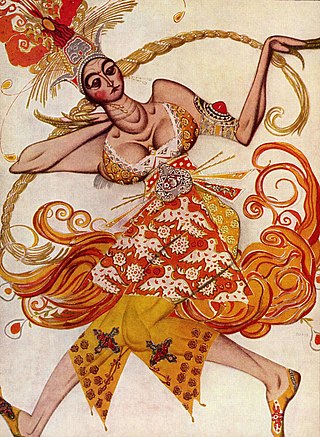
The Firebird is a ballet and orchestral concert work by the Russian composer Igor Stravinsky. It was written for the 1910 Paris season of Sergei Diaghilev's Ballets Russes company; the original choreography was by Michel Fokine, who collaborated with Alexandre Benois and others on a scenario based on the Russian fairy tales of the Firebird and the blessing and curse it possesses for its owner. It was first performed at the Opéra de Paris on 25 June 1910 and was an immediate success, catapulting Stravinsky to international fame and leading to future Diaghilev–Stravinsky collaborations including Petrushka (1911) and The Rite of Spring (1913).
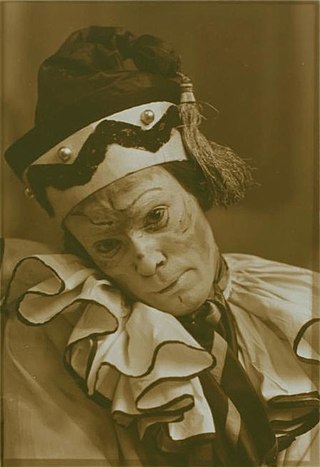
Petrushka is a ballet by Russian composer Igor Stravinsky. It was written for the 1911 Paris season of Sergei Diaghilev's Ballets Russes company; the original choreography was by Michel Fokine and stage designs and costumes by Alexandre Benois, who assisted Stravinsky with the libretto. The ballet premiered at the Théâtre du Châtelet on 13 June 1911 with Vaslav Nijinsky as Petrushka, Tamara Karsavina as the lead ballerina, Alexander Orlov as the Moor, and Enrico Cecchetti the charlatan.
The Wedding, or Svadebka (Russian: Свадебка), is a Russian-language ballet-cantata by Igor Stravinsky scored unusually for four vocal soloists, chorus, percussion and four pianos. Dedicating the work to impresario Sergei Diaghilev, the composer described it in French as "choreographed Russian scenes with singing and music" [sic], and it remains known by its French name of Les noces despite being Russian.
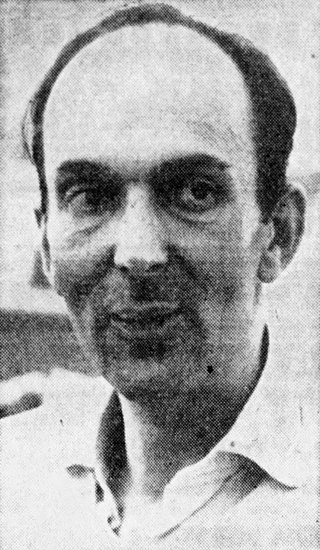
Igor Borisovich Markevitch was a Russian composer and conductor who studied and worked in Paris and became a naturalized Italian and French citizen in 1947 and 1982 respectively. He was commissioned in 1929 for a piano concerto by impresario Serge Diaghilev of the Ballet Russe de Monte Carlo.
The Petrushka chord is a recurring polytonal device used in Igor Stravinsky's ballet Petrushka and in later music. These two major triads, C major and F♯ major – a tritone apart – clash, "horribly with each other", when sounded together and create a dissonant chord.

The Ballets Russes was an itinerant ballet company begun in Paris that performed between 1909 and 1929 throughout Europe and on tours to North and South America. The company never performed in Russia, where the Revolution disrupted society. After its initial Paris season, the company had no formal ties there.
Le Baiser de la fée is a neoclassical ballet in one act and four scenes composed by Igor Stravinsky in 1928 and revised in 1950 for George Balanchine and the New York City Ballet. Based on Hans Christian Andersen's short story Isjomfruen, the work is an homage to Pyotr Ilyich Tchaikovsky, for the 35th anniversary of the composer's death. Stravinsky elaborated several melodies from early piano pieces and songs by Tchaikovsky in his score. A commission by Ida Rubinstein from 1927, the ballet was choreographed by Bronislava Nijinska and premiered in Paris on 27 November 1928.

Chout, Op. 21, is a ballet by Sergei Prokofiev. It was originally composed in 1915, then extensively revised at the request of Serge Diaghilev in 1921. The composer extracted an orchestral suite from it, Op. 21 bis. The ballet's full title is Tale of the Jester Who Outwits Seven Other Jesters. The most commonly used title for the work is based on the French transliteration of the Russian word for "jester", shut.
The Symphony in E-flat, Op. 1, is the first published work composed by Igor Stravinsky during his apprenticeship with Nikolai Rimsky-Korsakov. It is also his first composition for orchestra. Of classical structure, it is broadly influenced by Rimsky-Korsakov, Glazunov, Tchaikovsky and Wagner. It was composed in 1905–1907 and revised in 1913. It lasts for about forty minutes.
This is a sound and video discography of Igor Stravinsky's ballet The Rite of Spring. The work was premiered in Paris on May 29, 1913 at the Théâtre des Champs-Élysées. It was presented by Sergei Diaghilev's Ballets Russes with choreography by Vaslav Nijinsky and was conducted by Pierre Monteux. The list includes many of the most noted recordings of the work but is by no means exhaustive. The avant-garde character of the music, combined with Nijinsky's innovative choreography, caused a near riot at the first performance. It has since gained wide acceptance both as a ballet and as a concert piece.
Scherzo à la russe is a composition by Russian expatriate composer Igor Stravinsky. It was initially published by Chappell & Co. in 1945 and premiered in March 1946 by the San Francisco Symphony Orchestra, conducted by the composer himself. It was later published by Boosey & Hawkes.

Theodor Szántó, also seen as Tivadar Szántó was a Hungarian Jewish pianist and composer.